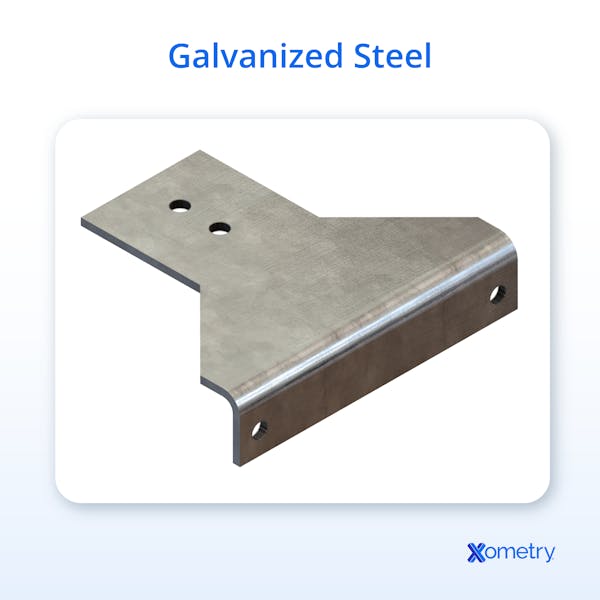Galvanized steel is steel that has been coated with zinc to increase its corrosion resistance. This coating has little or no effect on the magnetic properties of the steel itself. The zinc coating acts as a sacrificial anode, making galvanized steel more durable than the uncoated version.
This article discusses the magnetic properties of galvanized steel. It also discusses both the advantages and real-world applications of galvanized steel.
What Is Galvanized Steel?
Galvanized steel is carbon steel that has been coated with a protective layer of zinc to enhance its corrosion resistance. Since steel is an iron-based alloy, it is inherently prone to rusting when exposed to moisture. The zinc coating serves as both a physical barrier and chemical protection to shield the underlying steel from corrosive elements.
There are several different galvanizing manufacturing processes available; however, the most common one is known as hot-dip galvanizing. Another way to coat steel with zinc is by spraying it on. However, the zinc layer produced by spray galvanizing is considerably weaker than that produced by hot-dip galvanizing. During the hot-dip galvanization process, the steel to be coated is first cleaned, pickled in sulfuric acid, fluxed in a zinc-ammonium chloride solution, and then immersed in molten zinc.
The resultant zinc coating serves as both a physical and a chemical barrier, protecting the underlying steel from corrosion. Corrosive agents can't get to the surface of the steel through the zinc coating. However, even if a scratch or an edge exposes the steel to the atmosphere, the zinc can still protect it through an electrochemical process known as "cathodic protection."
The zinc, the iron in the steel, and the corrosive fluid create a galvanic cell, driven by zinc's greater propensity than iron's to react with its environment. The zinc acts as the anode in this electrochemical cell, oxidizing in a reaction with the corrodant (electrolyte) and giving up electrons. These electrons move toward the cathode, which, in this case, is the steel to be protected. The steel cathode is protected while the zinc oxidizes, serving as what is called a "sacrificial anode." The zinc corrodes in preference to the steel.
Fortunately, zinc’s corrosion products (also called the “zinc patina”) adhere tightly to the zinc layer’s surface, slowing the rate of corrosion to somewhere between 1 and 10% of the expected rate for unprotected steel.
Galvanized steel is renowned for its strength, formability, and resistance to corrosive elements, making it a widely used material in industries such as agriculture, solar power, automotive, and construction.
To learn more, see our guide on Galvanized Steel.
Is Galvanized Steel Magnetic?
Yes, galvanized steel is generally magnetic, but this depends on the underlying steel. Galvanization involves coating a steel substrate (typically carbon steel) with a layer of zinc to enhance corrosion resistance. While zinc is not magnetic, the thin zinc coating does not interfere with the steel's magnetic properties. Carbon steel, the most commonly galvanized material, is ferromagnetic, meaning it is strongly attracted to magnets. Therefore, galvanized carbon steel remains magnetic. However, not all steel alloys are magnetic. For example, austenitic stainless steels—such as grades 304 and 316—have a face-centered cubic (FCC) crystal structure and are typically non-magnetic, even when cold worked. While it is technically possible to galvanize austenitic stainless steel, it is uncommon and unnecessary, as stainless steels already offer intrinsic corrosion resistance.
Is Hot-Dipped Galvanized Steel Magnetic?
Yes, hot-dipped galvanized steel is magnetic. The steel substrate beneath the zinc coating retains its ferromagnetic properties, meaning it is strongly attracted to magnets. The zinc coating applied during the hot-dip galvanizing process is non-magnetic; however, it is thin enough not to interfere with the steel's magnetic response. Components made from hot-dip galvanized steel can still be used in applications where magnetic properties are required, such as in magnetic clamping systems or detection devices.
What Makes Galvanized Steel Magnetic?
What makes galvanized steel magnetic is the magnetic properties of the steel substrate. This magnetic quality is a result of the ferrous nature of steel. The addition of the zinc coating primarily serves to provide corrosion resistance rather than affecting the steel's magnetic nature.
How Does Galvanization Impact the Magnetic Properties of Steel?
The galvanization process generally has minimal impact on the magnetic properties of the steel. Steel is inherently magnetic due to its ferrous nature, and although zinc itself is not magnetic, the galvanized coating does not inhibit the steel's magnetic properties. This is because the zinc layer is very thin compared to the thickness of the steel. Therefore, galvanized steel maintains its magnetic characteristics.
How Does Galvanized Steel's Magnetism Compare With That of Stainless Steel?
Galvanized steel is generally magnetic because its core material, carbon steel, is inherently magnetic. The galvanization process, which involves applying a zinc coating to the steel surface, does not significantly alter the magnetic properties of the steel substrate.
In contrast, stainless steel’s magnetic behavior varies depending on its metallurgical structure. Ferritic and martensitic stainless steels, which contain iron, carbon (0.03 to 1.2%), and chromium (12 to 17%), are magnetic. Austenitic stainless steels, which have a different microstructure (based on a face-centered cubic crystal lattice), are non-magnetic. Galvanized versions of stainless steel may or may not be magnetic, with austenitic stainless steel remaining non-magnetic. However, galvanizing is typically unnecessary and not recommended for austenitic steel and stainless steel.
What Are Some Real-World Applications of Galvanized Steel?
Galvanized steel is used across a wide range of industries due to its excellent corrosion resistance, mechanical strength, and cost-effectiveness. Below are several key real-world applications:
- Road and Bridge Reinforcement: Galvanized steel is commonly used to reinforce roads and bridges, with galvanized rebar being a primary application. The zinc coating protects against rust, even when the surrounding concrete begins to degrade. Its sacrificial anode behavior—where zinc corrodes preferentially—extends the service life of these critical structures.
- Building Framing: In commercial and residential construction, galvanized steel is commonly used for framing structural elements, including beams and studs. The zinc layer protects against corrosion, allowing the framing to withstand moisture, minor damage, and wear without compromising its structural integrity.
- Outdoor Structures: Galvanized steel is used for canopies, solar panel supports, and more. It’s a popular choice for outdoor applications due to its durability and resistance to corrosion. This makes it ideal for outdoor structures that may encounter rain and some exposure over time.
- Drinking Water Pipes: Although less common today, galvanized steel was historically used in drinking water supply lines due to its corrosion-resistant coating. While it has largely been replaced by copper or plastic in modern plumbing, some legacy systems still contain galvanized steel pipes.
- Workshop Equipment: Many bolts, nuts, washers, wires, and hand tools are made from galvanized steel. The galvanization process provides sufficient corrosion resistance for typical indoor and intermittent outdoor use, making it a practical and economical choice for general hardware applications.
- Agricultural Applications: Galvanized steel is used in a range of applications, including grain storage silos, livestock enclosures, fencing, and storage structures. It performs well in abrasive and corrosive environments commonly found in agricultural settings, such as exposure to animal waste, soil, and chemicals. Its resistance to corrosion and mechanical wear, along with its affordability, makes it an ideal material for long-lasting agricultural infrastructure.

What Are the Benefits of Using Galvanized Steel?
Galvanized steel offers several key advantages that make it a preferred material in many industrial and construction applications:
- Corrosion Resistance: A zinc coating forms a protective barrier that shields the underlying steel from moisture and oxygen, significantly reducing the risk of rust and corrosion.
- Sacrificial Protection (Cathodic Protection): The zinc layer acts as a sacrificial anode, corroding in place of the steel to protect it from corrosion. This electrochemical process ensures that even if the steel surface is scratched or damaged, the surrounding zinc continues to protect the exposed areas.
- Durability and Longevity: Galvanized steel is known for its extended service life. In typical atmospheric conditions, properly galvanized steel can last over 50 years. In high-moisture or coastal environments, it can still perform effectively for 20–25 years without requiring major maintenance.
- Cost-Effectiveness: Galvanization is a relatively low-cost protective treatment compared to other corrosion-resistant coatings or stainless steel alternatives. It also reduces long-term maintenance and replacement costs, enhancing overall value.
What Should You Consider When Using Galvanized Steel in Magnetic Environments?
Galvanized steel, coated with a layer of zinc for corrosion resistance, although not as common, may exhibit altered magnetic properties due to the coating. It is crucial to assess the magnetic requirements of the specific environment and application. The thickness of the galvanized coating can significantly influence magnetic performance, making it essential to select an appropriate coating thickness. Generally, the coating has no significant effect on the magnetic properties; however, if the coating thickness is thicker than usual, it may have some impact. Additionally, factors such as the type of galvanizing process used and the composition of the steel substrate can impact the magnetic behavior.
What Are the Limitations of Galvanized Steel?
Although galvanized steel has numerous advantages, it also comes with some limitations. These include:
- Although galvanized steel is resistant to red rust, it can still develop “white rust,” a white, chalk-like product of the corrosion of the zinc coating.
- Galvanized steel is heavier than other lightweight, corrosion-resistant materials, such as aluminum. However, aluminum comes at a greater price. This is also true for titanium. Stainless steel of the same strength could also result in a smaller-volume, lighter-weight part.
- Not all objects can undergo the hot-dipping process—some items might be too large, while others might be too small or thin.
Common FAQs About Galvanized Steel
What Are Some Misconceptions About Galvanized Steel's Magnetism?
A common misconception about galvanized steel’s magnetism is that the zinc coating alters its magnetic properties. Many assume that the steel becomes non-magnetic after the zinc coating has been applied. In reality, galvanization has little to no impact on the steel's inherent magnetic properties, and it retains its magnetic characteristics after the process.
How Long Does Galvanized Steel Last?
Galvanized steel offers a long service life when properly applied and maintained. In typical atmospheric conditions, it can last more than 50 years without significant corrosion. In more aggressive environments—such as those with high moisture or industrial pollution—galvanized steel can still perform well, often lasting over 20 years without requiring maintenance.
However, exposure to saltwater or marine environments significantly reduces its lifespan. Saltwater is highly corrosive and accelerates the degradation of the protective zinc coating. While galvanized steel does provide a barrier against corrosion, prolonged or constant exposure to salt spray or immersion will eventually lead to coating breakdown and substrate corrosion. For such environments, additional protective measures, such as epoxy coatings, paint systems, or alternative materials like stainless steel, may be recommended to extend service life.
Is Galvanized Steel a Cost-Efficient Material?
Yes, galvanized steel is widely regarded as a cost-efficient material due to its combination of affordability, corrosion resistance, and durability. It is generally less expensive than stainless steel, which also resists corrosion but at a significantly higher material and fabrication cost. Galvanized steel can offer a service life of 50 to 100 years, depending on the environment and exposure conditions. This long lifespan reduces maintenance and replacement costs, making it a cost-effective choice for structural components, construction materials, and industrial products where corrosion resistance is essential.
Is Tin Magnetic?
Yes, tin is classified as a paramagnetic material, meaning it exhibits a very weak attraction to magnetic fields. However, this magnetic response is so minimal that tin is generally regarded as non-magnetic in practical applications. Paramagnetism in tin does not result in noticeable magnetic attraction, especially compared to ferromagnetic materials like iron or nickel.
Summary
This article presented galvanized steel's magnetism, explained it, and discussed its applications and benefits. To learn more about galvanized steel, contact a Xometry representative.
Xometry provides a wide range of manufacturing capabilities and other value-added services for all of your prototyping and production needs. Visit our website to learn more or to request a free, no-obligation quote.
Disclaimer
The content appearing on this webpage is for informational purposes only. Xometry makes no representation or warranty of any kind, be it expressed or implied, as to the accuracy, completeness, or validity of the information. Any performance parameters, geometric tolerances, specific design features, quality and types of materials, or processes should not be inferred to represent what will be delivered by third-party suppliers or manufacturers through Xometry’s network. Buyers seeking quotes for parts are responsible for defining the specific requirements for those parts. Please refer to our terms and conditions for more information.


